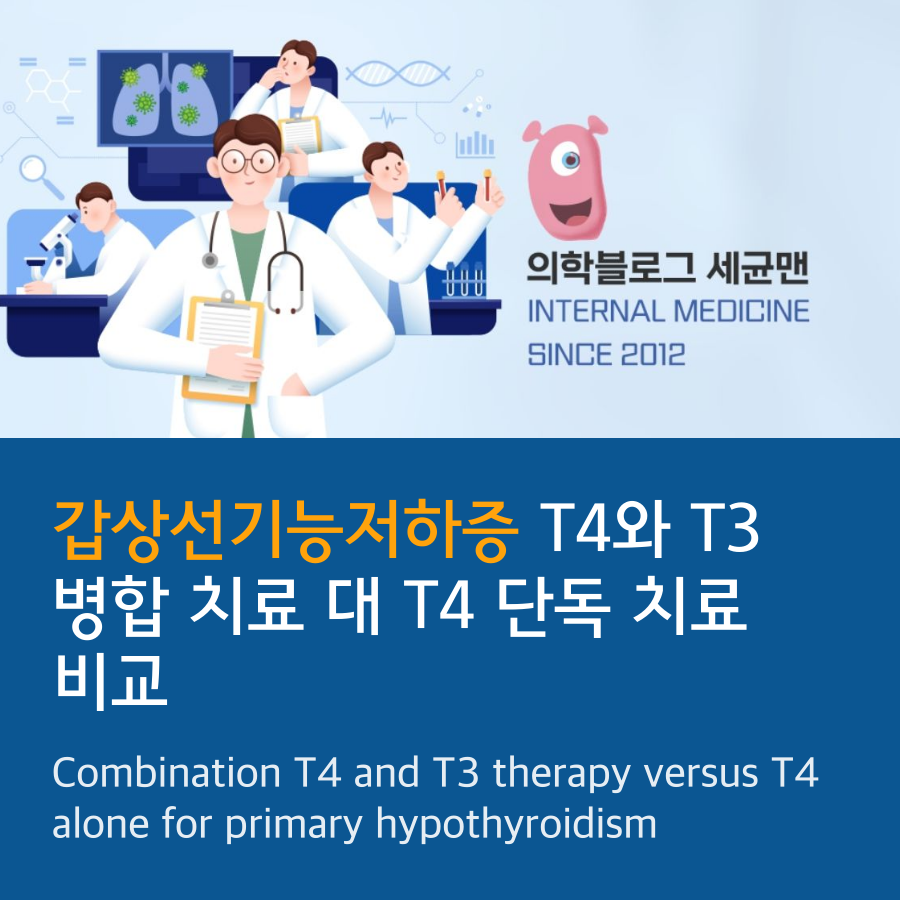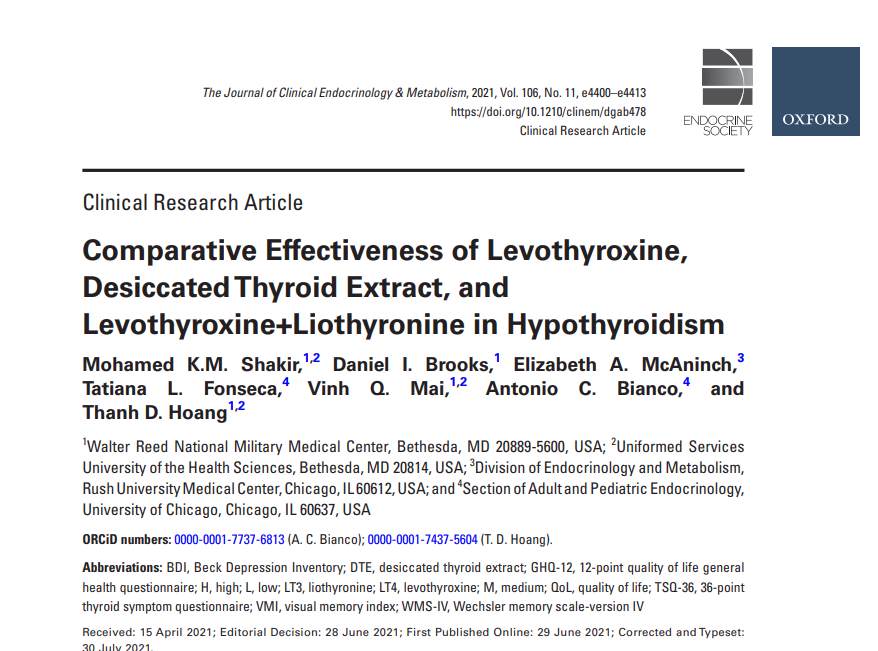
일부 갑상선기능저하증 환자들은 T4 공급으로 TSH를 정상화 시킨 이후에도 증상이 남아 있습니다.
이전에 안정된 용량의 T4로 치료 중이었던 75명 갑상선 환자에서 T4 단독, T4와 T3 병합, 건조 갑상선 추출물을 평가한 교차 시험을 시행하였고 환자의 선호도 또는 갑상선 증상 또는 일반건강설문 점수에서 차이가 없었습니다. 그러나 처음 가장 많은 증상이 있었던 20명의 환자는 T4 단독 치료보다 T4와 T3 병합치료 또는 갑상선 추출물에 대한 강한 선호를 보였고 점수에서도 유의미한 개선을 나타냈습니다. 이 하위그룹 분석은 갑상선기능 저하증의 원인, T4를 복용하는 동안 혈청 갑상선 검사, deiodinase 2 gene의 다형성 유무에서 유의미한 차이를 보이지 않았습니다. 비록 T4와 T3의 일상적 병합 사용을 제안하지 않지만 선택적 환자에서 T4와 T3 병합 치료 시도로 이득이 있을 수 있습니다.

Abstract
Introduction:
Studies comparing levothyroxine (LT4) therapy with LT4 + liothyronine (LT3) or desiccated thyroid extract (DTE) did not detect consistent superiority of either treatment. Here, we investigated these therapies, focusing on the whole group of LT4- treated hypothyroid patients, while also exploring the most symptomatic patients.
Methodology:
Prospective, randomized, double-blind, crossover study of 75 hypothyroid patients randomly allocated to 1 of 3 treatment arms, LT4, LT4 + LT3, and DTE, for 22 weeks. The primary outcomes were posttreatment scores on the 36-point thyroid symptom questionnaire (TSQ-36), 12-point quality of life general health questionnaire (GHQ-12), the Wechsler memory scale-version IV (VMS-IV), and the Beck Depression Inventory (BDI). Secondary endpoints included treatment preference, biochemical and metabolic parameters, etiology of hypothyroidism, and Thr92Ala-DIO2 gene polymorphism. Analyses were performed with a linear mixed model using subject as a random factor and group as a fixed effect.
Results:
Serum TSH remained within reference range across all treatment arms. There were no differences for primary and secondary outcomes, except for a minor increase in heart rate caused by DTE. Treatment preference was not different and there were no interferences of the etiology of hypothyroidism or Thr92Ala-DIO2 gene polymorphism in the outcomes. Subgroup analyses of the 1/3 most symptomatic patients on LT4 revealed strong preference for treatment containing T3, which improved performance on TSQ-36, GHQ-12, BDI, and visual memory index (VMS-IV component).
Conclusions:
As a group, outcomes were similar among hypothyroid patients taking DTE vs LT4 +T3 vs LT4. However, those patients that were most symptomatic on LT4 preferred and responded positively to therapy with LT4 + LT3 or DTE.
'내분비내과 > 갑상선기능저하증' 카테고리의 다른 글
| 2023 대한갑상선학회 무증상갑상선기능저하증 진료 권고안 (1) | 2024.05.01 |
|---|---|
| 갑상선호르몬을 복용 중인 환자에서 혈액검사는 언제 검사하면 좋은가? (0) | 2022.11.04 |
| 레보티록신 (갑상선 호르몬) 제제 사이의 변경 (0) | 2022.06.09 |
| 갑상선기능저하증에서 초기 모니터링과 약물 조정 (1) | 2022.06.09 |
| 갑상선기능저하증 위험이 있거나 임신 중인 여성에서 갑상선호르몬 처방 (0) | 2022.05.23 |



